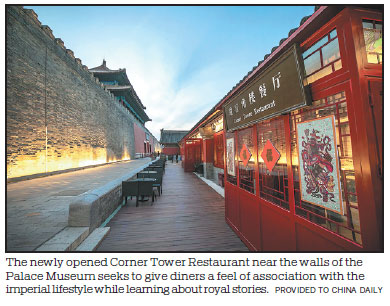New restaurant allows visitors to eat like royalty in the Forbidden City
The Qing Dynasty (1644-1911) emperor, Qianlong, ate hotpot more than 200 times in one particular year, according to the imperial dining archives.
In spring, he would eat pickled Chinese cabbage hotpot for breakfast; at the beginning of summer, the imperial kitchen would prepare Chinese yam and duck soup for him; in the fall, his breakfast included edible bird's nest and duck hotpot; and when the Winter Solstice finally arrived, Qianlong would eat hotpot with chicken, lamb and mushroom three times a day.
Just outside the Palace Museum's north entrance, the Gate of Divine Prowess (Shenwumen), is a row of red houses with more than 250 years' history running from east to west, which used to be dorms for the imperial guards.

Now, the east side of the red houses has become a popular site for young people to take photos when visiting the Palace Museum, which received almost 16.7 million visits in 2017, as it has been turned into the Corner Tower Restaurant, a place to enjoy hotpot like the emperors and the empresses of the old time.
The restaurant, which opened on Feb 5, the first day of Lunar New Year, has caught public imagination.
After all, who does not want to eat imperial-style hotpot near the Palace Museum.
The restaurant also serves traditional Beijing food such as Peking duck roll and old Beijing-style noodles with soybean paste in the day time. Hotpot is only served at dinner.
On Tuesday at 5:30 pm, Wang Yuhang, an employee at a commercial real estate company in Beijing, arrived at the restaurant to secure her reservation for a table for 12, as she and her colleagues were having a team-building event there.
Wang, who planned to enjoy the night scene of the Palace Museum after the meal, said: "To eat at this restaurant is interesting for us. The environment here is entertaining, and most of us like hotpot."
While Wang and her colleagues were enjoying their meal, outside the restaurant a walk-in diner spent two hours in a line waiting for a table.
The restaurant has been fully booked till March 10, and before that date, walk-in diners have to wait until the first round of diners finish eating, according to Shi Jie, the branding manager of the restaurant.
"We didn't expect the restaurant to be this popular, and we don't want diners to wait too long, so we will offer only a few reservations after March 10 so that the walk-in guests can spend less time waiting," says Shi.
The decor of the restaurant combines traditional imperial palace elements and cultural and creative ideas originating from the Palace Museum, also known as the Forbidden City, a former Chinese imperial palace complex.
A copy of a part of the painting of an imperial feast hosted by emperor Qianlong at the Ziguangge Pavilion covers the west wall of the restaurant.
The original painting by Yao Wenhan is now at the Palace Museum.
The north wall of the restaurant features portraits of five Qing emperors and empress, including emperor Qianlong and empress Fucha whose love stories are featured in the TV series Story of Yanxi Palace and Ruyi's Royal Love in the Palace.
"We want the diners to feel an attachment to the Palace Museum, and learn more about its stories while enjoying the food," Shi says.
As for the hotpot, the restaurant currently serves one base soup -the empress Dowager Cixi's favorite chrysanthemum one - together with five sauces in five colors.
The chrysanthemum soup base uses pig bones and mountain ginseng from Northeast China, which are boiled for more than 24 hours with a dozen other ingredients such as Chinese wolfberry or gouqi, jujube and longan.
According to Shi, the culinary team is now researching the hotpot enjoyed by emperor Qianlong and planning to launch a new soup base next month.
The menu is in the form of an imperial edict, while the table sign holder features an emperor sitting on a horse shooting an arrow and surrounded by two dogs.
The restaurant also sells Palace Museum souvenirs.
As far as food goes, the restaurant is not the only temptation in the area.
The west side of the red houses has a cafe, which opened on Dec 1. And it sells coffee and dessert. But influences from the Palace Museum proliferate.
Even the take-away cups have popular elements from the Palace Museum like Qianli Jiangshan Tu(A Thousand Li of Rivers and Mountains) and the Hall of Supreme Harmony.
The hot chocolate that emperor Kangxi used to drink is a popular drink and pictures of the red take-away coffee cup are often posted on social media platforms such as Sina Weibo and Instagram.
The Palace Museum is closed on Mondays, but both the Corner Tower Restaurant and the cafe are open seven days a week.
liyingxue@chinadaily.com.cn

(China Daily 03/06/2019 page15)


















